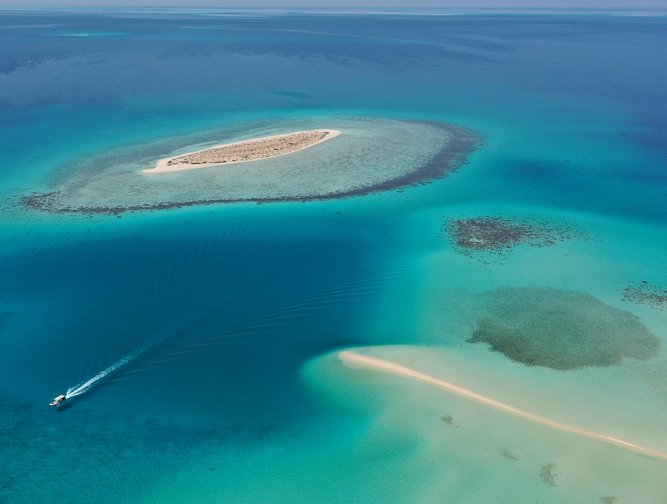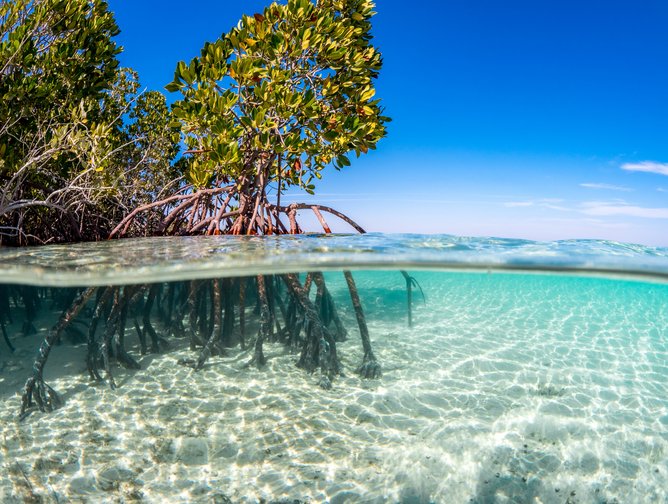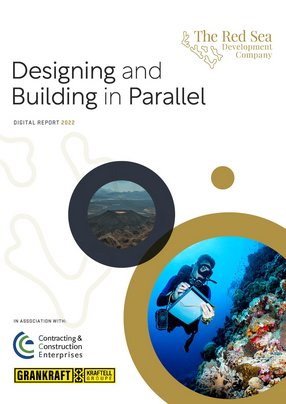The Red Sea Development Company: designing and building
Sporting a white Nike polo shirt, and fresh from attending the Jeddah Grand Prix, Ian Williamson, Group Chief Project Delivery Officer at The Red Sea Development Company (TRSDC), connects with me in his new on-site office he moved into a month ago, and looks at ease straddling the leisure-business divide.
For the next hour, such is his impressive grasp of all construction matters with the ambitious Red Sea Project, I don’t have much to say. He is out of the blocks faster than Lewis Hamilton and clearly wants to convey as much about all the myriad development components, and industry issues, in the time available.
TRSDC was incubated within Public Investment Fund (PIF) and formally formed into a private limited company, with all stock owned by PIF, in May 2018. It’s an integral part of Saudi Arabia’s Vision 2030, which is transitioning the country from an oil-based economy. Its mandate was to build the project, which covers 28,000sq kms of land mass, including a 3,500sq km archipelago containing 92 islands and 250kms of coastline.
“We equate it to the size of Belgium,” he said. “My role is to take approved design from our development arm, and convert to detailed design, procurement and construction, and handover to our operations team.”
Williamson joined as the ninth employee, and TRSDC’s workforce is now up to 1,500. The MasterPlan was signed off in November 2018, which was followed by an intensive design period. So far over SAR13 billion of work has been contracted which, when you factor in a PPP contract too, totals more than SAR18 billion overall.
“Everyone’s surprised that we’ve built quite a lot, as we’ve been constructing and designing in parallel. It’s what sets us apart. We’re contracting at a rate of close to SAR1 billion a month until we’ve completed the project buy out,” he said.
Along with juggling design and build, a ‘construct-and-manage’ approach provides direct access to the best subcontractors. “That means we haven’t got dependency over one or two contractors – who often have limited control over – and eliminate some of the mark ups,” he said.
BIM360 provides total visibility
BIM360 gives total visibility on the entire supply chain involved with the Red Sea Project. Designs can be exported and imported, providing not only progress on a weekly basis, but also stage deliverables.
“When you’re spending billions on a megaproject, you can be subject to information overload – and that can lead to information misplacement. Tools can enable data to be put into the right pigeon holes,” he said.
He said the main challenges are the hyper inflation of commodities and container costs, which are pressurising projects globally.
“Labour is also a key factor, and has a direct bearing on schedules. The contractors who have performed averagely have come in with a project mentality. The ones that are making impression are in for the long haul.”
While the pandemic has placed pressures on schedules, Williamson doesn’t want to make COVID an excuse, and says broadly, despite lockdowns and health and cargo restrictions, it is on track. “But we have seen slippage in some areas though, and started night working in the last couple of months,” he said.
Jewel in KSA tourism
With its clear coral-stacked waters, the Red Sea Project will be a jewel in KSA’s tourism crown. Tourism numbers will be restricted to 1m travellers a year. The site has attracted plenty of interest among divers, including Philippe Cousteau, who sits on its advisory board.
“You carry premium once you create scarcity, plus the natural beauty of the geography, lends itself to a luxury tourism project,” he said.
Today, it is halfway through construction of phase 1. Three hotels are scheduled to open at the end of 2022, and another 13 due to be completed by the end of 2023.
Last October, as it started getting on top of phase 1, TRSDC said it was ready to take on new projects.
That lead to it securing the AMAALA project, 300kms up the coastline, as well as around 12 other potential projects in the pipeline that are coastal or island-based, many of which are targeting a different audience – domestic travellers – in contrast to the global appeal of The Red Sea Project.
The first phase, Triple Bay, spans 11kms and it has a mountain range unusually sited by the coast. The three unique bays owe their existence to water run-off from the mountains. The nine hotels will target ultra luxury travellers, but with more focus on wellness, arts and culture, whereas Red Sea Project is more island based and about its natural attractions.
“They actually complement each other well, you can see guests coming to the Red Sea and exploring a bunch of alternative holiday destinations – there are exciting opportunities, as we create a ‘Red Sea Riviera’.
“There’s so much beautiful coral and mangroves, and it’s rare to come across more than 90 islands with no man-made footprint.”
But that is all set to change, and TRSDC is acutely aware of the need to preserve the environment as much as possible.
“We originally forecasted 50,000 workers on site, and looked at how we can get that down to 30,000. Clearly the way to do that is manufacture as much as you can off site.
“We’re working closely with Saudi Amana, which make prefinished ‘boxes’ and they can be entirely fabricated – from staircases to service ducts and lift shafts. You put all the components together like lego.”
Off-site manufacturing, involving timber, has also been evident with the first of its two hotels opening next year. “It’s all delivered to us flat-packed and you can have a villa up within a week. There is no cutting or adjustments on site. The more we can bring in that’s largely completed, and use finishing trades to put together, the more we can reduce the footfall on the islands.”
“Pod technology is also getting really advanced and the Saudis are great at pre-cast panels, but I think it will go a step further, as materials become more refined.
“We’ve just done a 100-metre borehole on one of our islands. Typically we take 20-25m samples for geotechnical studies, to analyse the substructures, but we needed to do a core structure which was interesting.”
Williamson said TRSDC is committed to building a ‘smart destination’, built around enhancing the guest experience and operational efficiencies. Luggage will be transported straight from the purpose-build airport to guests’ rooms.
New technologies are constantly being courted, but it hasn’t found a way of using 3D printing yet on site.
What is clear is that from the F1 tracks to the Red Sea islands, Saudi Arabia is entering 2022 in top gear.






